Key takeaways:
- Organic wine production emphasizes sustainable practices, nurturing soil health, and fostering biodiversity, leading to wines that authentically reflect their terroir.
- Low-intervention wines showcase unique flavors through minimal additives and natural yeasts, creating distinct tasting experiences that vary with each bottle.
- Comparison between conventional and organic wines highlights the character and storytelling potential of organic options, often perceived as more authentic and vibrant.
- Enhancing enjoyment of low-intervention wines involves mindful tasting, experimenting with food pairings, and choosing the right ambiance for a richer experience.
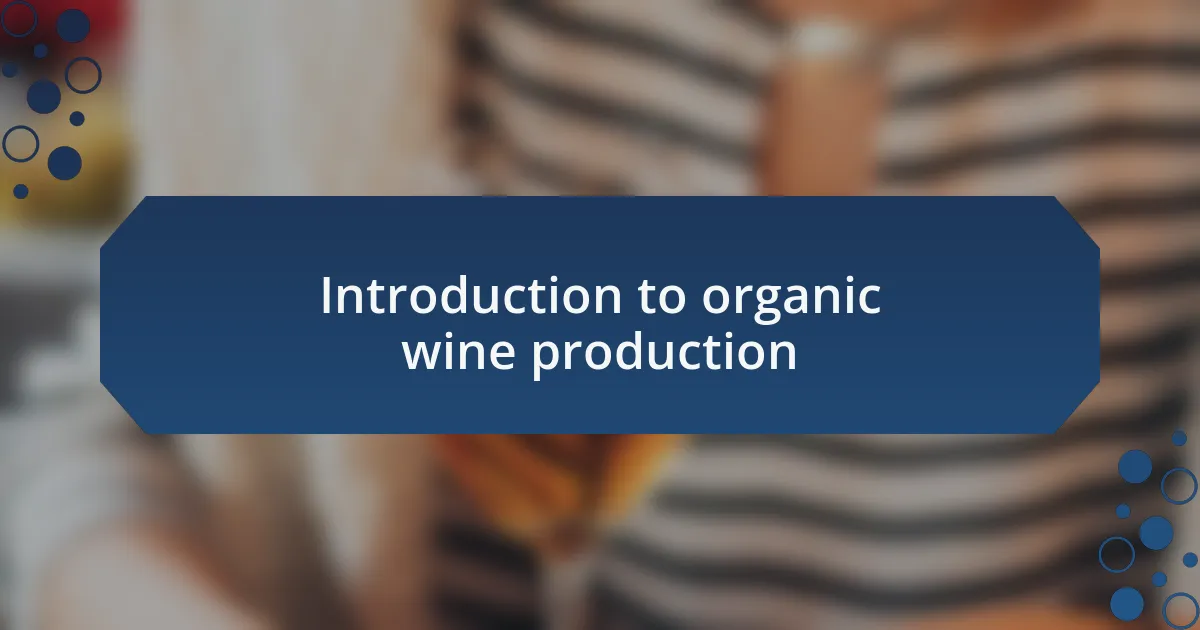
Introduction to organic wine production
Organic wine production is a fascinating journey that emphasizes a deep connection to the land. It invites winemakers to embrace nature’s nuances rather than impose their will on it. Have you ever tasted a wine that truly reflected the terroir—the unique characteristics of its environment? That’s often a hallmark of organic practices.
What I find captivating about organic wine is the commitment to sustainable agriculture. It’s not just about avoiding synthetic chemicals; it’s about nurturing the soil and fostering biodiversity. I remember visiting an organic vineyard where the air was alive with the sounds of insects and birds. It struck me how this vibrant ecosystem contributed to the exceptional quality of the wine.
Moreover, organic wines often express a sense of authenticity. Each bottle tells a story of its upbringing, and for me, there’s something incredibly special about sipping a wine that honors its origins. As I explore more low-intervention wines, I can’t help but wonder: how much of a difference does the production method really make in the taste experience? The answer is often found in the very essence of each sip.
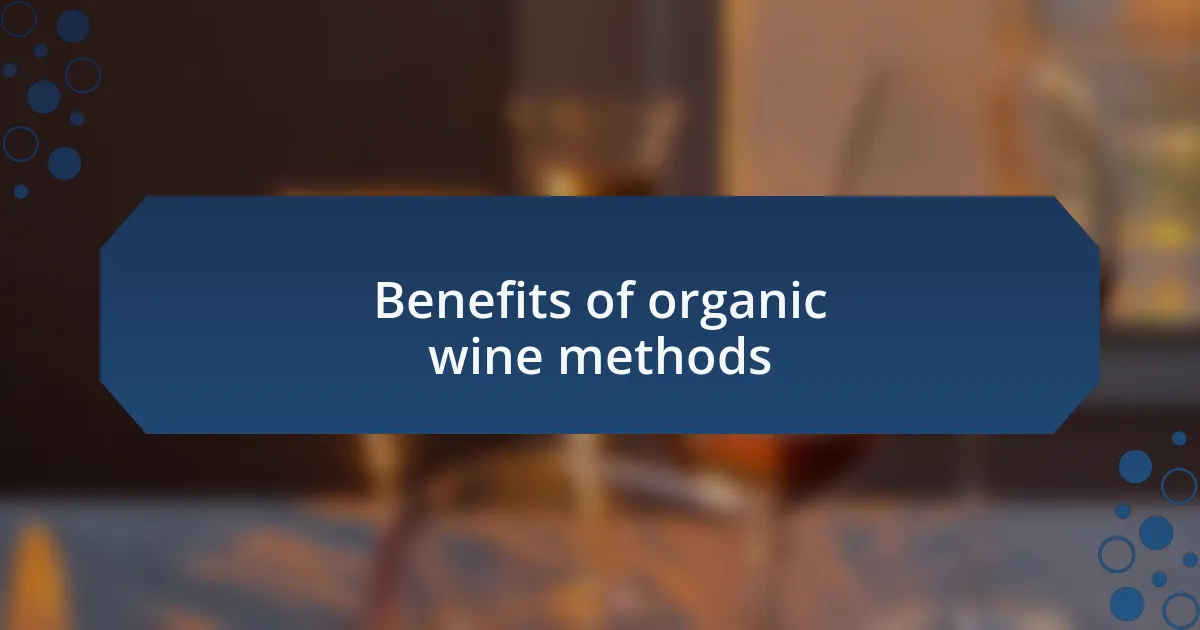
Benefits of organic wine methods
One of the most significant benefits of organic wine methods is the enhancement of flavor profiles. When winemakers avoid synthetic pesticides and fertilizers, the grapes develop more complex flavors, reflecting their natural environment. I remember tasting an organic Syrah that was so vibrant and nuanced, it compelled me to reconsider the notion that all wines taste similar. Isn’t it remarkable how the nuances of the vineyard can speak through every sip?
Additionally, organic methods contribute to the sustainability of the land. By prioritizing ecological balance, winemakers preserve vital soil health and promote biodiversity. I often think back to a vineyard I visited where cover crops were actively used to enrich the earth and attract beneficial insects. Witnessing this interplay between nature and viticulture was a strong reminder of the importance of maintaining our ecosystems. It raised a question in my mind: how can we reconcile wine production with environmental stewardship?
Lastly, organic wines often resonate with consumers seeking authenticity and transparency. Knowing that a wine is crafted with organic practices can enhance the drinking experience, making it feel like a conscious choice rather than just a moment of indulgence. I recall a delightful evening spent exploring organic wines with friends, where each bottle sparked discussions about its origins and production. It made me appreciate not just the wine itself, but the journey it underwent before reaching our glasses. How often do we get to share such meaningful connections over what we consume?
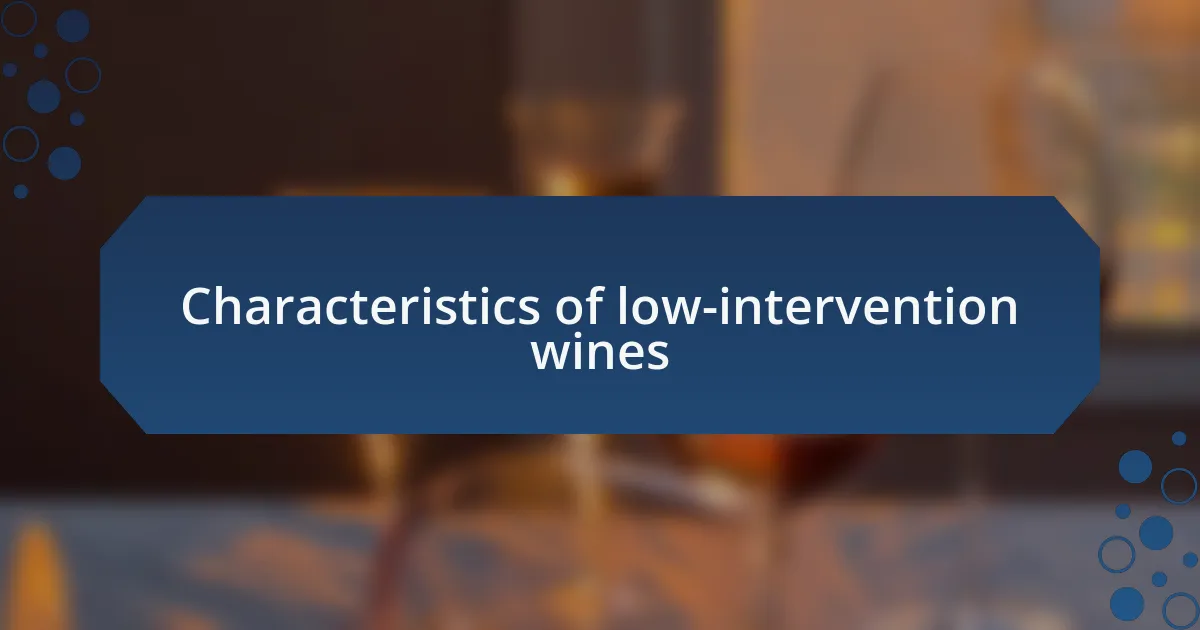
Characteristics of low-intervention wines
Low-intervention wines are often distinguished by their minimal use of additives and a hands-off approach during the winemaking process. I recall savoring a low-intervention white wine that had a subtle funk, a characteristic derived from wild yeasts. It felt like each sip told a story of the vineyard’s terroir, the unique blend of environment and technique. Did I notice the slight cloudiness in the glass? Absolutely. Instead of feeling off-putting, it added a layer of authenticity to my experience, making me wonder how many stories a glass of conventional wine might mask.
The fermentation process in low-intervention wines relies heavily on natural yeasts, leading to distinctive flavor profiles that can shift from bottle to bottle. I remember a spontaneous wine tasting where the same varietal showed entirely different characteristics based on each production year. Some were bright and zesty, while others deep and complex, reflecting their surrounding climate and soil conditions. Isn’t it fascinating how consistent, commercial wines often fall into predictable patterns, while low-intervention wines can surprise us time and again?
Another hallmark of low-intervention wines is their ability to showcase the vineyard’s unique identity without heavy manipulation. One time, I enjoyed a low-intervention Pinot Noir that was so expressive, it evoked the very landscape from which it came. Each sip was a lesson in authenticity; the wine felt alive, vibrant, and genuinely connected to its roots. This made me ask: how often do we let the true essence of a wine shine through, unfiltered by additives and processing?
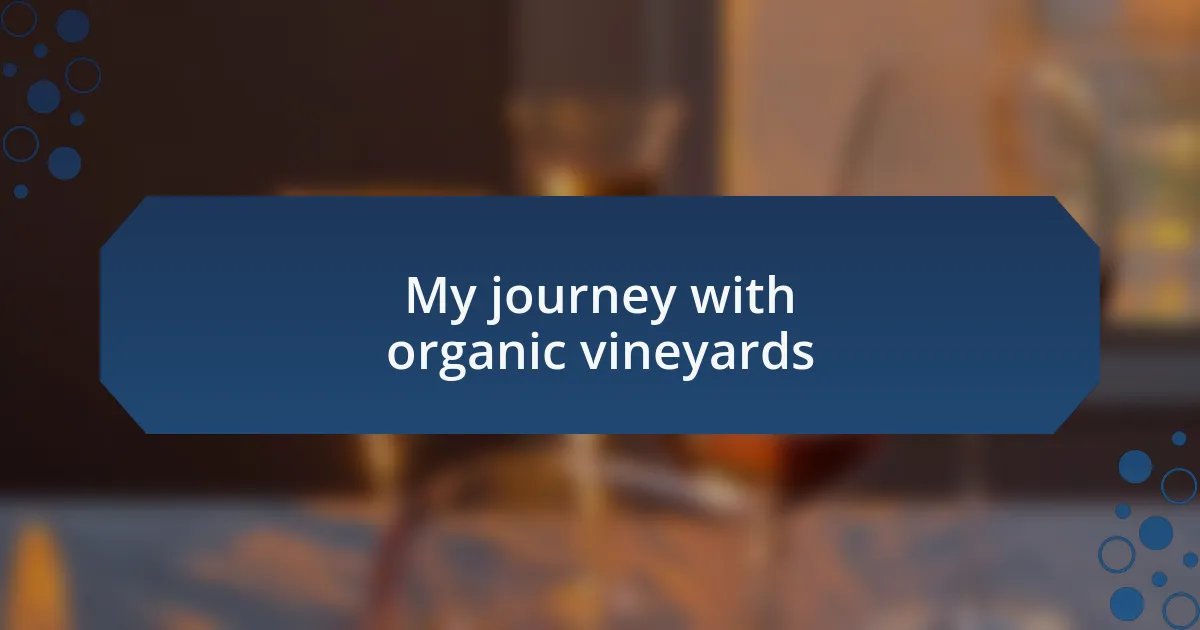
My journey with organic vineyards
As I ventured into the world of organic vineyards, I found myself captivated by the stories behind each bottle. One sunny afternoon, I visited a small vineyard nestled between rolling hills, where the owner proudly explained her philosophy of nurturing the grapes without synthetic fertilizers. The air was thick with the scent of ripe fruit, and I could feel the connection to the land in every sip of her wine. I often wonder, how many people truly appreciate the journey from vine to glass?
My visits to organic vineyards have transformed my understanding of winemaking. I recall a lively conversation with a winemaker who spoke passionately about his refusal to use commercial yeasts. As he poured his 2018 vintage, I was struck by this wine’s raw, unpolished charm. Each taste burst with the authenticity of its origins, making me reflect on the balance between nature and human touch in the artistry of wine.
On another occasion, I attended a harvest festival where the community celebrated their commitment to organic practices. Surrounded by laughter and clinking glasses, I felt a profound sense of belonging among those who shared the same values. It made me think: isn’t it the innate connection to nature that truly enhances our enjoyment of wine? Each encounter with these vineyards has enriched my palate and deepened my appreciation for the nuances of organic production.
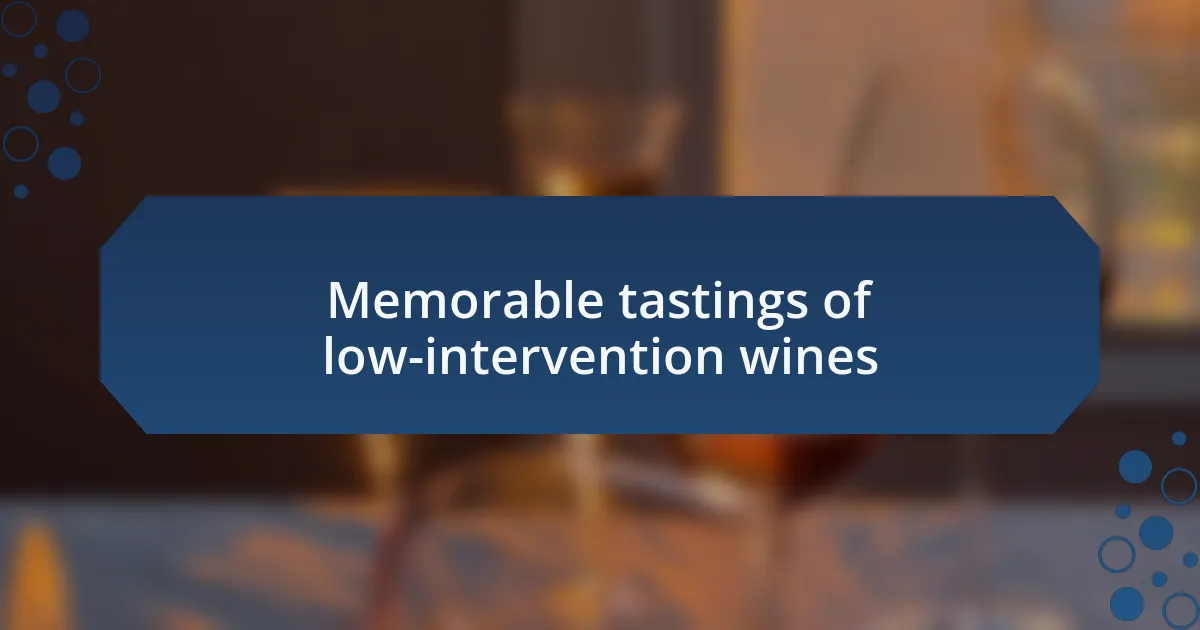
Memorable tastings of low-intervention wines
One of the most unforgettable tastings happened at a tiny, family-owned vineyard where the owner shared his first low-intervention blend, a playful mix of Grenache and Syrah. I vividly remember the way he described his grapes as “the essence of our land,” and as I sipped it, I could almost taste the sun-soaked soil. The wine danced on my palate, bringing forth flavors reminiscent of wild berries and a hint of earthiness that left me pondering: how can something so simple carry such depth?
During a spontaneous visit to a pop-up wine event, I encountered a low-intervention white that completely challenged my preconceptions. As the winemaker poured a glass of their skin-contact Pinot Grigio, the amber hue caught my eye, and my curiosity soared. I could hardly contain my excitement when the first sip revealed a mix of floral notes and spice that I had never experienced before; it truly felt like a conversation between nature and craftsmanship. It made me reflect on the hidden stories these wines can tell.
Another remarkable moment unfolded at a small urban winery, where a communal tasting allowed me to connect with other wine lovers. I sampled their quirky, petillant naturel, a naturally sparkling wine that seemed alive in the glass. Each bubble burst with excitement and laughter, and it struck me how low-intervention wines foster a sense of community and shared experience. Isn’t it fascinating how a single bottle can become a bridge that connects people with diverse backgrounds?
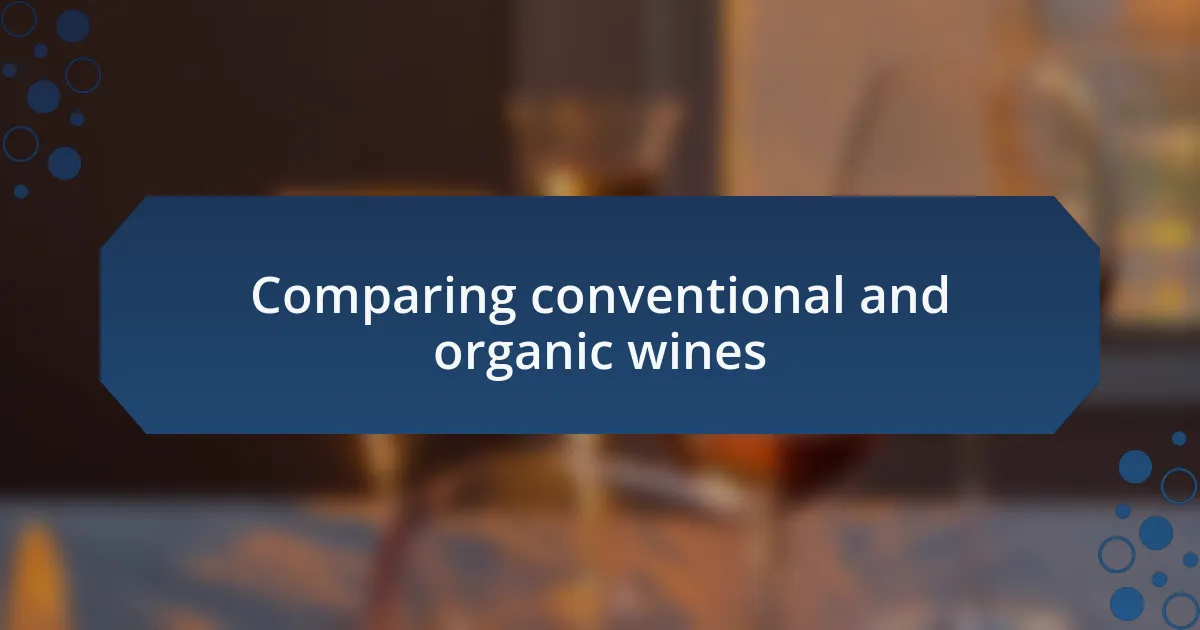
Comparing conventional and organic wines
Comparing conventional and organic wines reveals a fascinating contrast, particularly in approach and flavor perception. I recall a tasting where I tried a widely known commercial red alongside a small-batch organic version. The conventional wine tasted polished but lacked the character I found in the organic selection, which burst with a genuine, earthy essence that transported me to the vineyard itself. Have you ever noticed how some wines tell a story, while others feel more like a rehearsed performance?
There’s an undeniable charm in organic wines stemming from their minimal intervention during production. I remember a moment when I savored a biodynamic Merlot that had been aged in neutral oak barrels. Each sip was like an invitation to explore the terroir, the unique characteristics of the land it was grown on. In contrast, conventional wines often prioritize consistency over individuality, sometimes resulting in a more uniform tasting experience that doesn’t linger in the mind.
Choosing between conventional and organic wines ultimately leads to a personal journey of taste. I find the thrill in discovering the unpredictable flavors of organic wines, reminiscent of the unconventional paths these growers take. Have you ever explored a wine that surprised you, making you rethink your preferences? For me, it’s this adventure, the delightful unpredictability, that elevates the experience beyond mere drinking into something memorable and meaningful.
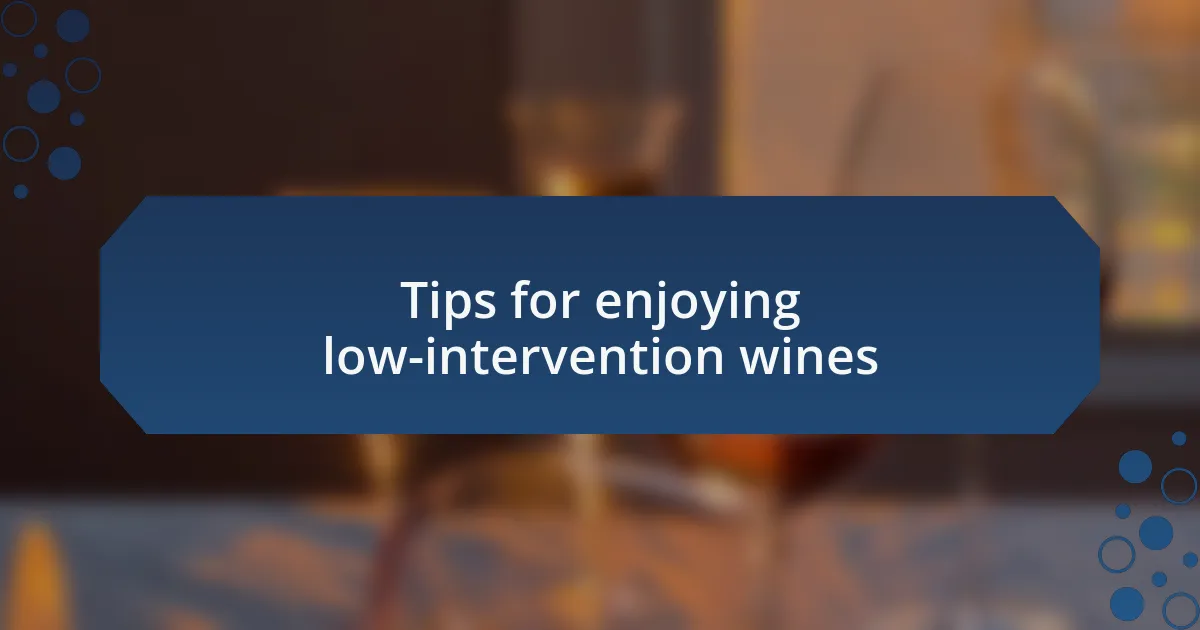
Tips for enjoying low-intervention wines
When it comes to enjoying low-intervention wines, I find that the right setting can truly enhance the experience. I once hosted a casual gathering with friends, pairing a vibrant skin-contact wine with an array of artisan cheeses. The flavors danced on our palates, and I could see everyone’s curiosity piqued as they asked about the wine’s unique characteristics. Have you ever had a moment where the ambiance not only complements the drink but elevates the entire atmosphere?
Taking the time to really engage with the wine is essential. When I first tasted a low-intervention Grenache, I spent a few minutes just appreciating its vivid color and aroma before taking a sip. That initial interaction made each flavor note more pronounced and memorable. This mindful approach invites you to appreciate the wine the way its creator intended. It’s amazing how awareness can change your entire perception, wouldn’t you agree?
Lastly, don’t hesitate to experiment with food pairings. I once paired a quirky, lightly sparkling orange wine with spicy Asian cuisine, and it was a revelation. The wine’s acidity countered the heat beautifully and opened up a dialogue about how wine can transform a meal. Have you tried unpredictable combinations? You might be surprised by how low-intervention wines enhance unexpected dishes, turning a simple meal into a delightful exploration.